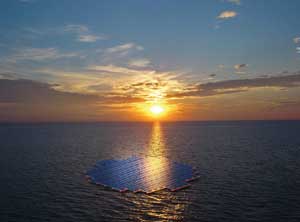Finding room for large arrays of solar
panels is not always easy, especially in industrial or agricultural areas. But for
Yossi Fisher, CEO of Solaris Synergy in Jerusalem, there is an obvious solution:
leveraging untapped water surfaces to deploy the first floating solar power plants.
The floating concentrated photovoltaic (PV) system not only overcomes
one of the key problems solar cell manufacturers face, namely the need for large
tracts of land, but it also produces electricity at a lower cost compared with standard
land-based photovoltaic panels. This added benefit comes thanks to the cooling effect
the water has on the panels.

An artist‘s illustration of one of Solaris Synergy’s 50-kW floating solar platforms.
“The water surface doesn’t just play a role as ‘real
estate’ for the system; we actively use it to obtain two major benefits,”
Fisher said. “The first is cooling of the solar cells. The cells in our system
are constantly kept at a low temperature (around 30 °C), thus avoiding the
normal heat degradation of efficiency seen in ordinary noncooled panels. Secondly,
we use the water surface as a giant, almost friction-free bearing to allow a simple
and inexpensive azimuthal sun-tracking mechanism.”
Fisher believes that the issue of land availability will become
a very real roadblock to widespread deployment of land-based PV systems and that
putting bodies of water to good use presents a welcome option to many.
Entities that own large inland water surfaces, such as power and
water utilities, and agricultural farms, particularly in the “sun belt”
area around the equator, will be most suitable. This takes in most of the Middle
East, southern Europe, north Africa, Central America and the southern US (California,
Arizona, Nevada), in addition to areas such as India and Australia.
The depth of water that is called for is surprisingly small –
typically anything greater than about 1 to 1.5 m is sufficient. As for the expanse
of water required, each module size is around 2 x 2 m, which means theoretically
that almost any body of water above this size could hold one of these systems. However,
to reach a meaningful system output, a surface of at least 1000 square meters is
required for a 100-kW system.
“A rectangular reservoir of water of a size of 100 m on
a side (a fairly small reservoir) would be able to produce 1 MWp,” Fisher
said. “No space around the reservoir is needed for the system, with the exception
of a small space of a few square meters for the inverters and transformer housing,
and small anchoring sites of one or two square meters each.”
The floating arrays are composed of standard crystalline silicon
solar cells with a slight modification made to the final metallization layer. A
higher metal conductor density is employed due to the use of concentrator mirrors.

A prototype of the floating concentrated photovoltaic system installed in Kibbutz Ketura, southern Israel. Images courtesy of Solaris Synergy.
“We only use a small fraction – about 5 to 8 percent
– of the silicon used by other nonconcentrating systems,” Fisher said.
“This allows us to use the best-performance cells we can find, without negatively
impacting the cost of our system to a significant extent. In addition, due to concentration, we get a higher output than normally rated for the given cells measured at ‘one sun’ conditions.”
The current low-volume cost per installed watt is around $3, with
projected costs (based on high-volume manufacturing and the attendant economies
of scale) going below $1.7/Wp fully installed within three to four years.
To date, Solaris Synergy has built two prototypes in its facility
in Jerusalem, plus a third prototype in a solar energy test site in Kibbutz Ketura
in the Arava region. The company has signed agreements with two partners to deploy
pilot projects of around 50 kW each with Israel’s national water company Mekorot/Watech and with the world’s largest utility company, France’s EDF Group. Some additional testing will take place at Cadarache in the southeast region of France.
“We hope to have these pilot projects finished within the
coming year and start to deploy the first commercial systems in 2012,” Fisher
said. “One of the challenges that all solar energy technology companies face
is the need to prove that the technology is sufficiently mature to be bankable –
this is a chasm that we have to cross.”